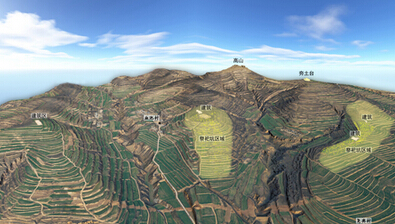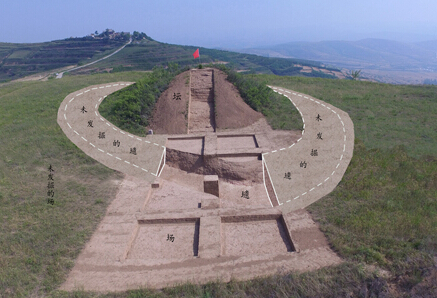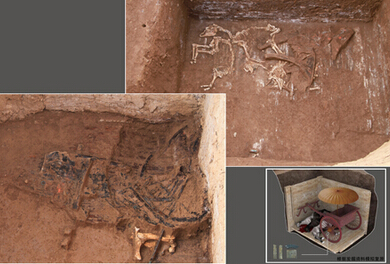Ancient Imperial Sacrifices Found in Fengxiang, Shaanxi
From: NetWriter:Date:2017-04-13
Xuechi (means “blood pool” named at ancient time) site, a sacrificial site that may have been used by the emperors of the Qin and Han dynasties has been excavated. It was located in Xuechi village, Fengxiang County, shaanxi Province. From April to November 2016, a joint archaeological team consisting of Shaanxi provincial institute of archaeology, National Museum of China and several local archaeological institutions completed the excavation of 2,000 square meters on the sacrificial site, and finished the total 4,700,000 square meters field survey as well. At present, more than 3200 archaeological remains such as buildings, activity fields, roads and sacrificial pits have been confirmed. This year, the archaeological team mainly focused on two remains with different characters, the rammed-earth platform and the sacrificial pit.
Landforms,environment and the distribution of xuechi site

The section plan of the rammed-earth platform
Archaeological Discoveries
The rammed-earth platform was situated at the top of the east-side mountain ridge. It has a circular mound shaped base, measured 5.2 meters in height and 23.5 meters in diameter, with rough rammed lower part and dense rammed upper part. According to the features on the platform, the unearthed cultural relics dating back to the Qin and Han dynasties and the later period ceramic-made building materials, there used to have small-scale buildings such as pavilions and attics on the top of the platform which used continuously after Qin and Han dynasties. There is a round Wei structure (circle of low enclosure) surrounded the rammed-earth platform. Outside the Wei, 3-step terraces were distributed, while the inner-step tread surface was dense but the others have vanished due to farming. During the field survey, several roads remains that were all leading to the platform from different directions were found by archaeologists. On the basis of this archaeological excavated evidence, combined with its geographic location, topographic condition and historical records, the rammed-earth platform was considered as Zhi complex where ancient Qin and Han emperors held ritual activities, offering sacrifices to gods and earth as well as the 5 emperors in legendary.

The wooden carriage and horse remains unearthed from the ancient sacrificial pit.
As for the field investigation survey to the remains at the mountain ridge, a few rammed-earth constructions as well as some building materials such as imbrex, pan-tiles and eaves-tiles dating back to Warring States period and early phase of western Han Dynasty were found. Damaged by the nature, livestock and farming, the whole building was no longer existed, but in terms of the scale, it could be divided into different levels, from the large-scale palace to the general small-scale building. All these findings were corresponding to the historical records, that the building community had the function of the hall of Abstinence for the emperor, resident for protocol officers and the storage for sacrificial utensils.

The wooden carriage and horse remains unearthed from the ancient sacrificial pit.
Intensively distributed sacrificial pits were the main archaeological features in the Xuechi site. It can be divided into three categories: Type A “Chariot pits”, Type B “irregular- shaped sacrificial animal flesh pit” and Type C “empty pit”. Type A including 3 different structures: First, the large vertical deep pit; Second, the narrow and long straight vertical pit; Third, vertical pit with head niche, it has the similar size as the second, inside the pit, the chariot and burial objects were all small but delicate, which revealed the modeled characteristic trend of funerary ware. Most Type B pits were in irregular- shape and buried with sacrificial animal flesh such as horses, cattle, sheep and goat. Some of the sacrificial pits were robbed, but abundant cultural relics were uncovered still. At present, archaeologists found more than 2,100 relics, mainly including jade artifacts (such as jade figurine, jade Huang pendant, jade Cong tube, jade Bi disk and so on), bronze chariots and horses ornaments (such as crossbow,
Wei the end-piece of axle, Xian curb bit, Biao curb chain, rings, stud, tube and so on), bronze arrowheads and some small wooden chariot which is specialized for sacrificial activities and so on. So far, the soil sample in type C’ empty pit has been collected by archaeologist to test whether it used to have “blood sacrifice” activities or not. Meanwhile, several artifacts were taken out for the surface detection, to check out if the historical records “burning worship” trace was existed or not. Xuechi village where the sacrificial site located means “blood pool” named at ancient time, which probably related with killing animal to offer sacrifices and collecting blood location.
Academic Significance
Xuechi site was the first Zhi remains (where ancient Qin and Han emperors held ritual activities, offering sacrifices to gods and earth as well as the 5 emperors in legendary) with complete structure ever found in China. It provides physical evidence that the worship activities were carried out from the Qin to Han Dynasties at Yong ancient city (regarded as the royal capital), it was considered as a ritual worship functional area where ancient Qin and Han emperors held sacrificial activities. Moreover, the excavation made it clear about the spatial distribution and cultural connotation of the ancient Yong city. According to the typology and chronology, Xuechi site was confirmed as the highest state-level sacrificial place Northern Zhi located at the Yong city suburb, based on Qin dynasty Zhi complex, which was set by Western Han dynasty emperor Liu Bang for rulers to worship the heavens . Therefore, Xuechi site is the earliest, largest, long-lasting and complete functional structure "royal altar of heaven" ever found in ancient Yong city after West Zhi complex at Luantingshan site. The archaeological findings are important for the study of political and ritual systems during that Qin and Han dynasty. (Translator: Zhang Chen)

